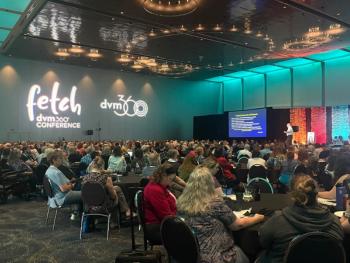
Antifungal drugs (Proceedings)
There are a number of classes of antifungal drugs.
There are a number of classes of antifungal drugs. Research in antifungal drugs has increased dramatically in the last two decades with the advances in organ transplantation and the epidemic of AIDS. The original antifungal drug was amphotericin B representing the polyene family. Amphotericin B damages the ergosterol of the fungal cell membrane. The next group of drugs was the azoles that inhibit the synthesis of the fungal ergosterol in the cell membrane. These are an important group of fungistatic drugs. Members of this group include ketoconazole, itraconazole, fluconazole as well as newer member such as voriconazole and posaconazole. The allylamine group interferes with ergosterol production in a different manner than the azoles and is effective when azole resistance develops. Terbinafine is the representative of the allylamine group. The glucan synthesis inhibitors interfere with the synthesis of the glucan component of the fungal cell wall thereby providing a different mechanism of action than the other antifungal drugs. The development of many new drugs for fungal infection is encouraging but the high cost of many of the new drugs is prohibitive for long term treatment.
Amphotericin B is the oldest of the antifungal drugs and remains the "gold standard." It is effective against a wide range of fungal organisms and acts in a fungicidal manner damaging the ergosterol of fungal organisms. The damage of the ergosterol results in leakage of the cell and cell death. The need for intravenous administration and the nephrotoxicity of amphotericin B limits its usefulness in long term treatment of fungal infections. It is still very effective for initial treatment of fungal infections because of its rapid action and intravenous route. In dogs with blastomycosis involving the central nervous system it appears to be superior to itraconazole. In dogs with histoplasmosis of the intestinal tract, malabsorption precludes the oral administration of azoles. Amphotericin B can be given initially to restore the function of the intestinal tract so that oral drugs can be used. Short term use of amphotericin B can be done without significant renal damage. It is lifesaving in these situations. There are a number of new amphotericin B drugs that reduce the renal toxicity by lipid encapsulation of the drug. This may be especially useful in infections such as histoplasmosis where the encapsulated drug is phagocytosed by the same macrophages that contain the fungal organisms. This brings drugs and organisms together. The lipid encapsulated drug is expensive and requires an increased dose of amphotericin B.
To avoid amphotericin B renal toxicity, animals need to be well hydrated before giving the drug. Diuresis does not reduce renal toxicity in hydrated dogs but administration over a 3 to 4 hour period reduces renal damage. The drug should be given every 48 hours. BUNs should be done before each dose and drug discontinued as the BUN approaches 50 mg/dl. Starting drug dose in dogs is 0.5 mg/kg and 0.25 mg/kg in cats. There is minimal data on liposome encapsulated amphotericin B but a suggested starting dose is 1 mg/kg. Amphotericin B is as effective as intravenously available azoles but is much cheaper.
Ketoconazole is the first of the azole group of antifungal drugs. The newer azoles such as itraconazole and fluconazole are more effective than ketoconazole and have less toxicity. Ketoconazole frequently produces anorexia in cats. Ketoconazole has a place in the treatment of Malassezia in dogs and has some antiinflammatory effect in addition to its antifungal activity. Ketoconazole seems to be a fairly good drug for coccidioidomycosis but fluconazole is probably better.
Itraconazole is a triazole type of antifungal azole synthesized in 1980. It is available as an oral agent and as an intravenous drug. The intravenous drug is very expensive. It has a broad spectrum of activity and would be considered the drug of choice for blastomycosis and histoplasmosis. It would be a good starting point for treatment of the myriad of saprophytic soil organisms that occasionally cause disease. The pelleted form of the drug is fat soluble and is best given with a fatty meal. The liquid form of the drug is best absorbed on an empty stomach. Beware of the compounded drug because of problems with absorption. A good starting dose for itraconazole in a variety of fungal infections is 10 mg/kg per day divided into 2 doses. In blastomycosis, a dose of 5 mg/kg/day is as effective as the higher dose. The capsules may be opened and the pellets mixed with a high fat food or butter for treatment of cats. Because of the long half-life of the drug, approximation of the dose is adequate. While some studies show effectiveness of itraconazole in treatment of experimental central nervous system cryptococcosis in rabbits, it is not the preferred drug for treatment of central nervous system fungal infections. Animals should be monitored for liver toxicity and when serum ALT levels exceed 200 IU/dl occur consider changing drugs. Drug toxicity is directly related to serum drug concentration with dogs that absorb the drug well more prone to toxicity. When anorexia occurs, discontinue the drug until appetite returns and restart the drug at half the previous dose. An ulcerative dermatitis occurs in less than 10% of dogs treated with 10 mg/kg/day. Determine by cytology of the lesions if the skin lesions are due to recurrence of the fungal infection. If it is believe to be a drug reaction, change to another drug or stop the drug and reduce the dose of the itraconazole after lesions have healed.
Fluconazole is a triazole that penetrates into the eye and central nervous system. Its best activity is against Cryptococcus, Coccidioidomycosis and Candida species. It is excreted in the urine providing good therapy for susceptible fungal infections of the urinary tract. A dose of 5 mg/kg twice a day in dogs or 50 mg tablet per cat twice a day is recommended. It is less effective than itraconazole for blastomycosis and histoplasmosis. Anorexia and increases in ALT are signs of hepatic toxicity.
Voriconazole and posaconazole are a new generation of azoles that have better activity against Aspergillus sp. They should be considered for systemic aspergillosis caused by Aspergillus terreus. There have been no effective drugs previously for systemic aspergillosis but this new group of azoles shows a 50% plus in vitro efficacy which is encouraging. These drugs are expensive and there are no reports in dogs to verify their clinical efficacy.
Clotrimazole is a topical azole that has excellent activity against nasal aspergillosis. It can be very irritating to the respiratory tract. Special precautions must be taken to protect the airway when treating the nasal passages.
Terbinafine is a broad spectrum, oral antifungal drug that interferes with ergosterol synthesis. It interferes with squalene epoxidase necessary for ergosterol synthesis at a different point than the azoles thereby reducing the likelihood of cross resistance. It has been safely and effectively used in a limited number of infections at a dose of 5 mg/kg twice a day in dogs and cats. It has been most helpful in cats with cryptococcosis whose infection has become resistant to the azoles. It can be considered whenever there is toxicity or resistance to itraconazole. The price is similar to itraconazole.
A new class of antifungals, the glucan synthesis inhibitors, has become available for use in people for aspergillosis. The glucans are a necessary component of the fungal cell wall. Caspofungin is a representative drug of this group of Echinocandins. They are effective in vitro against most isolates of Aspergillus terreus. They are available only for intravenous use and are very expensive.
The best starting drug for use against the common fungal infections has been established. When the infecting organism becomes resistant to treatment or when a fungal infection is due to one of the hundred plus types of normally saprophytic soil organisms, culture and sensitivity testing is helpful. Fungal cultures should be done at the local laboratory and isolates sent out for sensitivity testing. The Fungal Testing Laboratories at the University of Texas in San Antonio provides antifungal drug sensitivity. They can also measure serum drug concentrations to assure that there is adequate absorption of the antifungal drugs. Their web site can be found at
Newsletter
From exam room tips to practice management insights, get trusted veterinary news delivered straight to your inbox—subscribe to dvm360.




